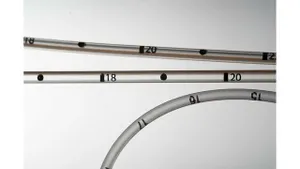Machine Makers Tailor Offering To Arduous Times
July 1, 2003
If there was one message from extrusion equipment manufacturers heard during Plast 2003 in Milan during May, it was that they are offering hard-pressed processors ways to improve operations without huge investments. Reduced maintenance, retrofitting, and modular (buy-what-you-need) equipment were appealing to processors’ thinner wallets.
“This is a very difficult market,” says Paolo Ceol, manager film extrusion, Plastimac (Milan, Italy). “If you want to sustain business, you need to offer processors innovative concepts.” A number of new developments displayed tried to tempt processors to invest now—despite the poor world economy—to be prepared for the boom to come, whenever that happens.
Luigi Bandera (Busto Arsizio, Italy) premiered a seven-layer blown-film line for EVOH and/or nylon barrier packaging. Film thickness is .03 to .2 mm, with a 1650-mm layflat width. The seven single-screw extruders (L/D ratio 30:1) allow screw extraction from the rear, thereby eliminating the need to dismantle the units. This can be done in half the time of previous front-loading units, says Silvio Zattra, product manager. The melt chambers of the 570-mm diameter die have been redesigned to reduce residence time and prevent melt degradation.
Zattra says that conceivably a processor could produce a 14-layer barrier film by collapsing and welding the bubble together to provide extra high gas barrier protection. But he discounts the economies of such applications, which he calls over-engineered and an uneconomical use of resin. “A processor really should be able to come up with equal barrier protection with seven-layer if he gets his proportions right,” Zattra says.
Also new at Plast was Bandera’s Twinpounder 2CV55HT corotating twin-screw compounding extruder, with screw diameter of 57 mm an L/D ratio of 42:l. The previous model rotated at 600 rpm. This new model goes up to 1200 rpm and targets filled polypropylene and nylon 6 grades.
Meccanica Alto Milanese (MAM; Olgiate Olona, Italy) demonstrated a narrow web (1m) three-layer coextrusion line processing polyolefins. Marketing Manager Susanna Colombo sees a demand for equipment that can produce small lots with quick changeovers of materials. Competitor Plastimac also offered a narrow web three-layer coex line (MB Coex) with the extruders placed parallel rather than in star formation to reduce footprint. Like the MAM line this unit targets film for high-graphic shopping bags.
Friul Filiere (Buia, Italy) presented a new single-screw extrusion line with higher output than previous models and improved sound dampening to produce profiles, doors, and siding. Also new were its Superlight profiles with densities of .4 to .05 g/cc made of polystyrene, PP, and PE, rather than the company’s traditional higher density PVC.
A single-screw extruder, EA60HP, designed for PE pipe and featuring improved conveying and melting efficiency through a grooved feed zone and screw, was shown by Amut (Novara, Italy). It features wear-resistant bimetallic barrels and a screw L/D of 33:1. Its thermo-regulation has been strengthened by more efficient dissipaters, allowing good high-speed production control.
The family of three LCM-AX corotating twin-screw compounders was promoted by Techint (Castellanza, Italy) to produce fire retardant and special masterbatches. Dry blending is carried out in the first mixing section. Materials are separately fed to the mixing hopper for preblending and preheating. The second section is combined with a throttling valve where the material enters a shear action zone between rotor tips and the chamber wall for mixing, backflow along the rotor axis, and kneading.
Competitor OMC (Saronno, Italy) showed a 20-mm-diameter corotating compounder, model EBV20/40, for lab operations. It replaces a smaller 19-mm-diameter screw unit. It has a 40:1 L/D and offers 10 kg/h throughput.
You May Also Like


